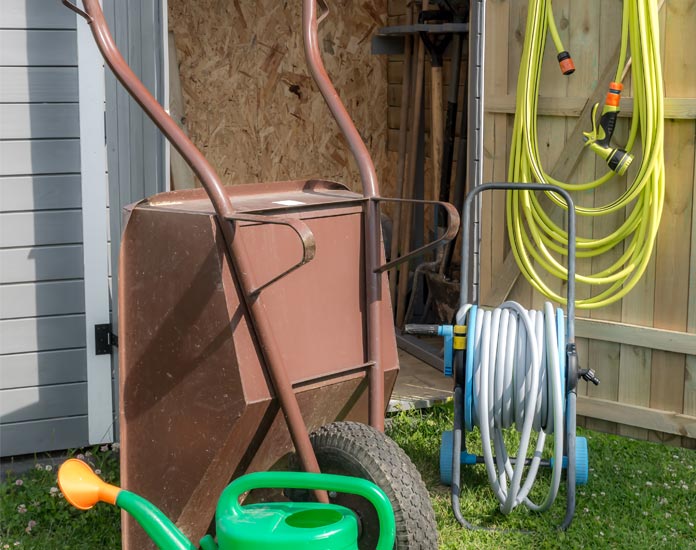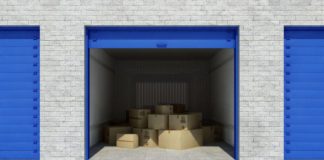In-home storage isn’t always as sufficient as we may need, especially when it comes to storing tools, garden supplies, and sports equipment. Luckily, outdoor storage can be a convenient and cost-effective option. Whether you have extra room in your garage, or a storage shed out back, these areas can provide the space you need to keep your items organized and accessible. However, outdoor storage can also come with its own set of challenges. From adverse weather and pests to potential safety hazards, it’s important to take some precautions to ensure that your belongings are safe and in good condition. To help maximize your efforts, here are nine steps for tackling outdoor storage.
How to Organize Sheds and Garages
Over time, it’s common for people to take on the “out of sight, out of mind” mentality when it comes to outdoor storage. The more items you put away, the less you think about them. Until one day, you need to access something and open the doors to find a chaotic mess. This can result in hours spent trying to reach your items, and potential safety hazards along the way. If you want to avoid falling victim to this inconvenience, all you need to do is follow the steps below on how to organize your shed or garage.
1. Take Everything Out
The first thing you should do is remove everything and either lay your items on the lawn or on the driveway. This will give you a blank slate to work with, allowing you to see the space you have available more clearly. Not only will this be easier for big picture organization, but it can also give you a better idea of how to maximize the space available in your outdoor storage to make it more efficient. However, before you start putting things back into their place, continue working through these steps.
2. Get Rid of Unnecessary Items
Once everything is removed from your outdoor storage, take some time to inspect your items. Are there things you forgot you had? Things you don’t use? Duplicate items? When you have everything laid out, you can evaluate your inventory with ease, thus making it the perfect time to get rid of things you no longer need or use. If you plan to get rid of something, decide whether you want to donate it, try to sell it, or throw it away. Whenever you’re in doubt, try to get rid of an item. Organization works best when you don’t hang on to things you won’t need.
Once you’ve sorted your items, it’s time to act. Although there are some great ways to make money off your clutter, if you don’t want to go through the effort of making listings and meeting buyers, donate it. If an item seems like it’s broken or no longer safe to use, throw it away or recycle it. Some items might need special handling, so check with your local recycling company or waste management facility if you’re not sure how to properly dispose of it.
3. Clean Out the Shed or Garage
Next, prepare your shed or garage for the next step by thoroughly cleaning it. This should include sweeping, vacuuming, or even power washing the floor and walls to get rid of any debris or dirt that may have accumulated over time. While doing this, check for any signs of damage on the walls, along the floorboards, etc.
Depending on when you last cleaned your outdoor storage and how dirty things are, this step might take some time. Try to give yourself a full day or save it for a weekend project. This will help ensure that you fully complete the task once you start. Dust corners, wipe off countertops, and don’t ignore the hard-to-reach areas. You want your shed or garage to be as clean as possible before you start putting things back inside.
4. Categorize Different Items
Now that everything’s clean, you can start to envision how you’ll want your shed or garage to be organized. One of the best ways to do this is by organizing your belongings into categories. Use the lawn or the driveway so you can see everything before you start putting things away. One way to do this is to separate items by type—gardening tools, sports equipment, hardware, tools, cleaning equipment, etc. You can then consider which items in each group are used the most often, so they can be kept at the front of that “region” when you put things back. Seasonal decoration or clothing may also be another category. If you have any hazardous materials, make sure that they’re separate from other, potentially reactive substances and consider taking some extra precautions when putting them back.
5. Choose the Right Storage Containers
Once you’ve separated things into their respective categories, consider the type of storage containers you’ll need. Choosing the right type of storage containers for outdoor storage is important to keep your belongings safe and protected from the elements. There are three primary options you can choose from: plastic, metal, and wooden.
Plastic storage containers are durable, lightweight, and weather-resistant. If your outdoor storage receives any sunlight, look for containers made from UV-resistant plastic to prevent fading and cracking. These are great for tools, cleaning supplies, and sports equipment.
Metal storage containers are sturdy and offer excellent protection from weather and pests. They are especially useful for storing valuable or heavy items, as they are more resistant to impact.
Wooden storage containers are attractive and can blend in with the natural surroundings in outdoor spaces. These are good options if you’re looking for additional storage around the shed or garage. However, they may require more maintenance.
Try to find something that’s secure, has good ventilation, and is an appropriate size for your needs. This will help optimize your organization and reduce the risk of damaging your belongings. If you plan to be moving things, like tools, consider an option with wheels.
6. Put Things into Containers with Labels
Next, start putting your belongings into their respective storage containers. Try to organize things so that containers are lightweight and easy to maneuver and keep things within their categories for easier retrieval later. Once you’ve finished a box, label it. You can store containers on open shelving units, with vertical storage from floor to ceiling, or using above the head storage to maximize space in your garage.
7. Try to Keep Items Off the Ground
If your outdoor storage isn’t too secure, it might be a good idea to use pallets and keep items from directly touching the ground. This can help safeguard things in case of bad weather, floods, or pests. Alternatively, you could opt for raised shelving units or create your own shelves that allow you to easily store things off the ground.
8. Take Measures to Protect Items from Pests
Speaking of which, taking further measures to protect your outdoor storage from pests may be necessary depending on where you live. Using airtight containers can help, but so can maintaining a clean and orderly area. Clean spills as soon as possible and try to keep food away. If you’re having issues, consider using natural pest repellents or working with a professional pest control company. You can also strengthen your storage by sealing any cracks or gaps with caulk or weather stripping to help prevent pests from entering.
Although outdoor storage solutions can offer some convenient access to tools and other supplies, they can be difficult to maintain over time. To help ensure that your items stay in great condition for years to come, opt for climate-controlled self-storage units from The Lock Up Self Storage. At The Lock Up, we have all the amenities you’d expect in a premium self-storage facility. Plus, since all our units are climate controlled, you can rest assured that your belongings are in good hands and safe from pests or bad weather. We also offer flexible leasing options, so you can alternate between sizes if your storage needs change. To give you even more peace of mind, our locations are equipped with top-of-the-line security features including security-controlled gate access, motion-sensitive lighting, 24-hour camera monitoring, and perimeter alarms. Many of our locations also offer electronic coded access specific to each tenant. To find a self-storage unit, contact one of the representatives at The Lock Up Self Storage today. Give us a call at 1-866-327-LOCK or find a unit online today!



















